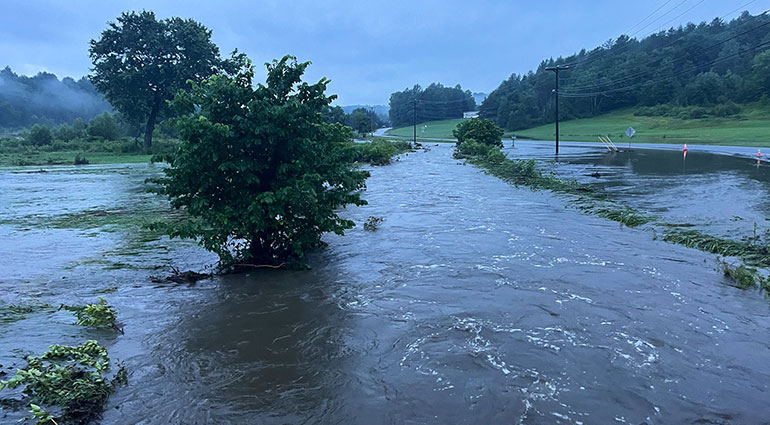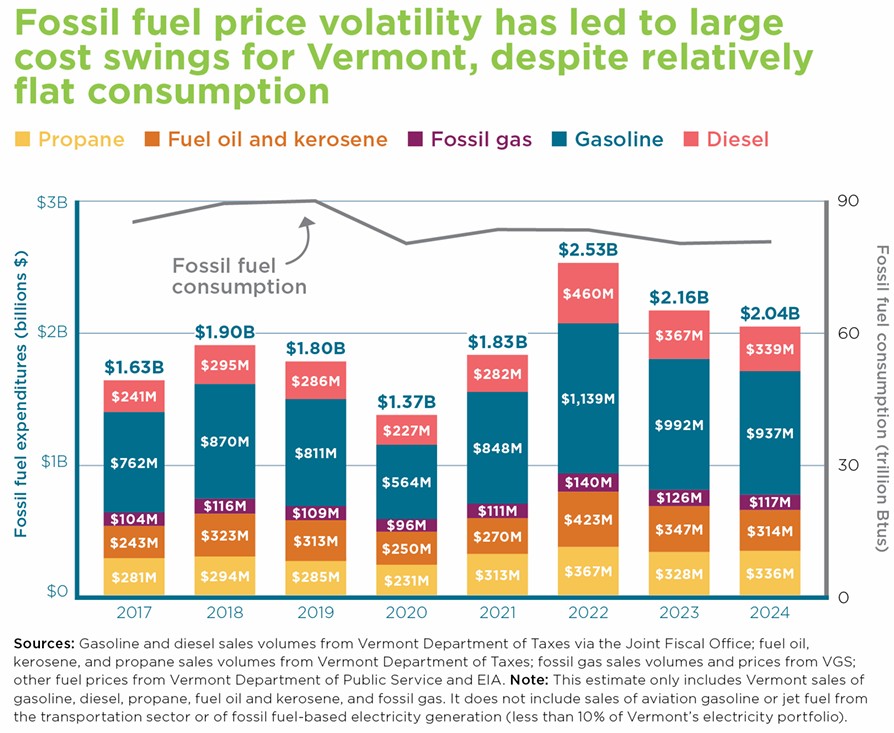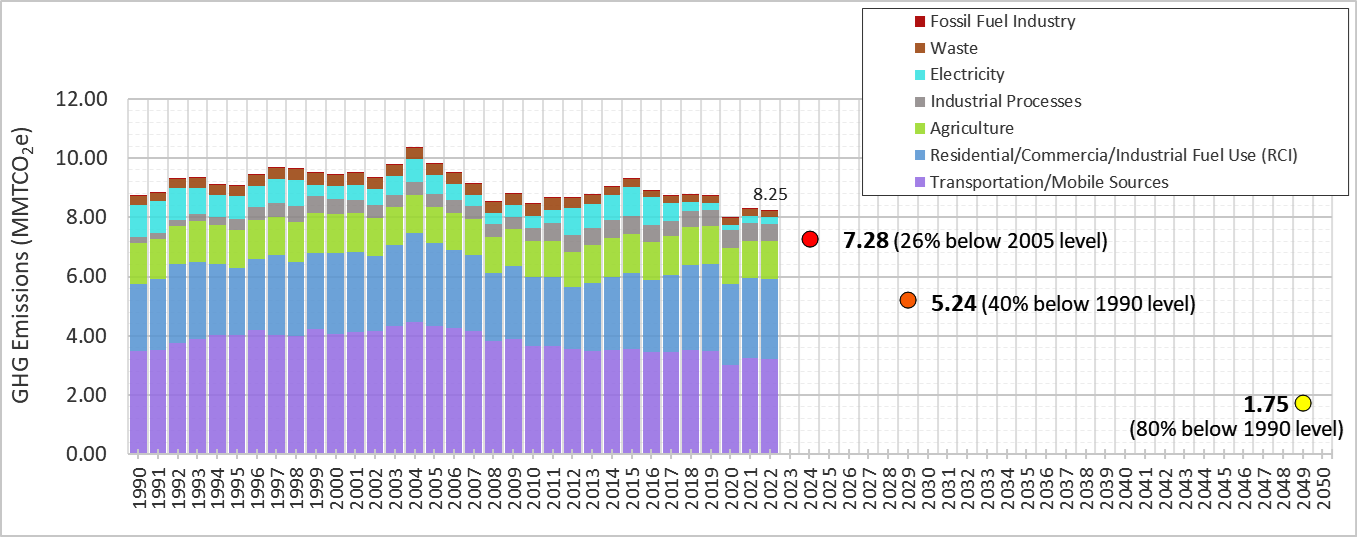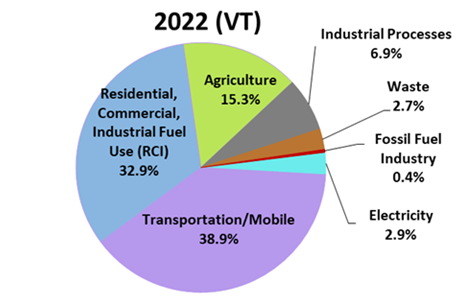
Photo: Severe flooding, blamed in part on global climate change due to greenhouse gas emissions, hit Vermont in July 2023 and in 2024. Courtesy photo.
ANR Climate Action Office Releases Annual Greenhouse Gas Emissions Inventory for Vermont
VermontBiz The Agency of Natural Resources’ (ANR) Climate Action Office (CAO) released the latest Greenhouse Gas Emissions Inventory and Forecast (GHG Inventory) on July 18, the state’s official measure for evaluating progress towards the emissions reduction requirements of the Global Warming Solutions Act.
The most recent GHG data shows 2022 emissions (most recent available) are at their lowest level on record, outside the COVID-19 pandemic drop in 2020.
However, there would still need to be a steep drop in emissions by the next goal in 2024 emissions.
GHG emissions in 2022 were 8.25, they would need to be 7.28 by 2024, 5.24 in 2029 and 1.75 MMTCO2e by 2049 (Million Metric Tons of Carbon Dioxide Equivalent). These goals are based on percentages of previous levels: 2025 would be 26% below 2005 level; 2029 would be 40% below 1990 level; and 2049 would be 80% below 1990 level.
Emissions track government efforts to reduce carbon-based energy consumption, and also the general economy. Better economic conditions generally result in higher GHG emissions.
The effects of recent efforts by the Trump Administration to boost natural gas (methane) and oil production, while reducing incentives for alternative energy sources and conservation, will not show up in the data for several years, as there is a three-year data lag.
The report covers emissions from 1990 through 2022. As with previous years, there is a delay in completing the inventory while national datasets are updated and reviewed to ensure accuracy. The 2024 goal has come and gone but the data will not be available until July 2027.
The Energy Action Network, for one, in its analysis, believes the state has missed that goal. From its data, based on energy consumption, EAN estimates that Vermont was at 7.75-8.29 MMTCO2e (or 8.02, ± 0.27 MMTCO2 e) in 2024.
EAN said this translates to falling 18%-39% short of Vermont’s first statewide emissions reduction legal obligation under the Global Warming Solutions Act (GWSA).

This is not surprising to anyone.
The trend line was flat for the four years before the COVID-19 pandemic, took a steep dive in 2020 when many industries, like construction, were forced to shut down for a time, and only increased somewhat in 2021 and 2022. Given that transportation is the largest source of energy consumption in Vermont, the work-from-home effort likely played a significant role. Electric vehicle use also surged, while still a minor fraction of total transportation.
Offsetting all that is the sunsetting of some incentives on renewable energy generation, particularly solar, at a time of economic growth. The US economy grew profoundly in 2023 and 2024, which suggests GHG emissions also grew.
Looking at the ANR chart, the economic cycles can be tracked in part by GHG emissions: 1990-91 (inflation, high interest rates, debt recession), 2002 (dot-com bubble, post 9/11 recession), 2007-2009 (Great Recession) and 2020 (COVID recession). An economic, and GHG, surge then followed during the recovery periods.

Total and Sector-Based Vermont Greenhouse Gas Emissions (1990 – 2022)
In 2022, transportation and heating fuel used in buildings remained Vermont’s largest sources of greenhouse gas emissions – consistent with previous inventories. Vermont’s total emissions fell modestly as compared to 2021, as both transportation and heating fuel use declined slightly.
Vermont is one of 23 states that creates its own state emissions inventory, which it has produced since 2007. Vermont collaborates with other states for consistency in emissions accounting. ANR uses emissions data and tools developed by the Environmental Protection Agency (EPA) supplemented with local data to lend further accuracy.
Every year, ANR refines the data used in the GHG Inventory, incorporating updates provided by EPA about historical data. The updates also reflect current scientific research about how much different fuel types contribute to global warming. These improvements make the GHG Inventory more accurate, but they also affect Vermont’s emissions reduction targets.
Since the Global Warming Solutions Act requirements are set as percentages of baseline emissions from 1990 and 2005 rather than fixed number (i.e., emissions must be reduced 26% below 2005 levels by January 1, 2025), any change to those baseline years automatically adjusts the requirements. As a result, this update resulted in a slightly lower 2025 target, while the 2030 and 2050 targets increased slightly.
Beyond tracking Vermont’s past emissions, the GHG Inventory also projects the state’s future emissions over the next 5 and 10 years. These forecasts assume that current policy, programs, technologies, and consumer behavior continue on their present trajectory.
To better understand Vermont’s climate impact, ANR also conducts a Life Cycle Analysis. The Life Cycle Analysis reflects the cumulative emissions generated throughout an energy source’s journey. Specifically, whereas the GHG Inventory only counts the emissions released when a gallon of fossil fuel is burned, the Life Cycle Analysis also accounts for the emissions from drilling for oil, refining it into gasoline, and shipping it to local gas stations.
Now in its second year, this analysis works alongside the Greenhouse Gas Inventory to give policymakers a more complete understanding of Vermont’s climate footprint, helping inform decisions about the state’s energy future.
ANR updates the GHG Inventory annually in July.
The Energy Action Network (EAN), meanwhile, tries to estimate current GHG emissions in order to get around the three-year waiting period.
Last April it released a report using monthly data available from the Vermont Department of Taxes enables near real-time tracking of statewide fossil fuel sales in Vermont.
The report summarizes data from 2017 through 2024.
As of January 1, 2025, Vermont is estimated to have reduced statewide GHG emissions 16-21% below 2005 levels. Contributing to this progress, as of the end of 2024, Vermonters have registered nearly 18,000 electric vehicles, comprehensively weatherized over 40,000 homes, and installed over 20,000 heat pump water heaters and over 70,000 heat pump units.
However, the science-based commitment made in the Global Warming Solutions Act (GWSA) is a 26% reduction below 2005 levels by 2025. Vermont almost certainly did not meet the first emissions reduction deadline (January 1, 2025) of the GWSA.
Vermont’s combined transportation and thermal sector (heating) GHG emissions in 2024 were likely 5.57 million metric tons. This is about 370,000 metric tons higher than emissions from those sectors would have needed to be to achieve their proportional sectoral targets in alignment with the first emissions reduction obligation of the GWSA.
In order to make up for the excess emissions from the transportation and thermal sectors, we would need to see an approximately 29% reduction in GHG emissions across all other sectors between 2021 to 2024 – something which we lack either historical or recent data to suggest is plausible.
Based on currently available data, EAN estimates that 2024 statewide GHG emissions in Vermont were likely between 7.75 – 8.29 MMTCO2 e (or 8.02, ± 0.27 MMTCO2 e). This translates to falling 18-39% short of Vermont’s first statewide emissions reduction legal obligation under the GWSA.
These findings underscore that emissions reductions do not occur absent clear market signals in the form of concerted state policy, rules, and programs designed to cost-effectively and equitably cut climate pollution and energy costs.
That Vermont almost certainly did not meet the first obligation of its GWSA is not because it was not possible to do so. Rather, it comes as a predictable result of Vermont not implementing policies, regulations, and programs to cost-effectively and equitably cut climate pollution in line with commitments made in state law. Time is of the essence if we want to get on track – both in terms of seizing the opportunity to reduce costs to Vermonters by lessening dependence on high-cost and price-volatile fossil fuels, and in terms of meeting our responsibility to reduce climate pollution in line with science-based legal commitments.
Ben Edgerly Walsh, Climate & Energy Program Director, at VPIRG was more pointed in the role the state has played and can play.
“First, I’ll say that these numbers are not a surprise. The Scott Administration has thrown up barriers to virtually every major climate action proposed in his tenure, other than spending federal funds. His answer, year in and year out, is to study the problem, then study it some more, always leaving action for some point after the next election. What’s more, the Energy Action Network clearly demonstrated last year that the state was not on track it hit its 2025 requirements, despite ANR’s inaccurate modeling – a conclusion ANR eventually accepted, which is borne out in these data.”
“As for the kinds of actions the state needs to take to get back on track to meet our legal requirements, they’re not a mystery – they’re the kinds of things laid out in the climate action plan, like joining a cap and invest program. The Renewable Energy Standard – which Scott vetoed – ensures that pollution from the electric sector will continue to fall over the coming decade as more renewable energy comes online. Now we need to replicate that success in the heating and transportation sectors. It also requires the state stand up to the Trump Administration, like AG Clark has been doing. Trump’s illegal actions, like freezing EV charging funding Vermont is owed under federal law, or attempting to end the clean cars program Vermont is part of, are certainly making things harder, which is why it’s so encouraging to see our Attorney General challenging them.”
Meanwhile, a suit brought by the Conservation Law Foundation last September over the state’s failure to adequately prepare to meet the 2025 target was dismissed by a judge on July 18.
Just as Vermont Attorney General Charity Clark has sued the Trump Administration on many fronts, including energy, Senator Bernie Sanders (I-Vermont) on July 25 reintroduced the End Polluter Welfare Act, which is legislation to eliminate Trump’s new handouts to the fossil fuel industry contained in the reconciliation “Big, Beautiful Bill.” The Sanders bill would also eliminate existing polluter welfare for the fossil fuel industry.
First introduced by Sanders in 2012, the bill eliminates more than $190 billion in tax loopholes and federal subsidies for the fossil fuel industry over the next 10 years. That total includes approximately $20 billion in new subsidies for coal, oil drilling, methane emissions, pipelines and other false climate solutions. The bill would also prevent the Trump administration from handing out hundreds of millions of acres of public lands and waters for drilling.
Sanders said the Republican reconciliation bill passed in early July by a single vote in the Senate includes enormous new subsidies to the fossil fuel industry:
More than $1.48 billion in tax cuts for metallurgical coal;
More than $14 billion in tax cuts for carbon capture and enhanced oil recovery;
Up to $3 billion in tax cuts for owners of power plants and pipelines that transport carbon and dirty hydrogen;
Up to $447 million in tax cuts that help oil and gas drillers avoid the 15 percent corporate minimum tax;
$1.5 billion in tax cuts for fossil fuel producers who emit methane, a greenhouse gas 84 times more potent than carbon dioxide;
A “pay-to-play” scheme that will allow polluters to buy environmental reviews; and
Opening up hundreds of millions of acres of our public lands and waters for drilling.
Instead of handing out new taxpayer subsidies to Big Oil, Sanders said Congress “must take on the greed of the tremendously profitable fossil fuel industry” by passing the End Polluter Welfare Act, which would:
Eliminate all giveaways, tax preferences and loopholes to the fossil fuel industry;
Prohibit taxpayer-funded fossil fuel research and development;
Update below-market royalty rates for oil and gas production on federal lands;
Recoup royalties from offshore drilling in public waters;
Ensure competitive bidding and leasing practices for coal developments on federal lands; and
End support for international oil, gas and coal projects to help the international community move away from dirty fossil fuels to clean sources of power.
Edgerly Walsh has some hope despite the politically uphill battle in Congress: “As for the GOP’s recent passage of Trump’s big, ugly bill, of course that will make things harder and slower – but the truth is, the economics of the clean energy transition are so beneficial that even the president and congress can’t stop it.”
The state, meanwhile, has made progress despite all of the above.
The Vermont Climate Council successfully met the July 1, 2025, deadline that requires the Council to adopt a new Climate Action Plan. This plan includes a suite of strategies to equitably and affordably cut planet-warming pollution, reduce energy costs and enhance resiliency in a climate-changed world. The plan includes a set of 52 priority recommendations as well as a top ten list of recommended actions for the state to advance as key strategies.
The updated plan contains more than 50 priority recommendations, emphasizing actions that:
Make Vermont more resilient to flooding and other climate-related hazards
Reduce climate pollution from transportation and buildings by moving from fossil fuels to electricity and strengthening the electric grid
Support climate-informed land use and conservation
Grow the climate workforce and identify funding to accelerate implementation
The plan also identifies key considerations for policymakers when designing and implementing climate action policy, including the need to:
Recognize unprecedented federal investment in climate action is abruptly ending
Design and pace climate action programs in a manner that limits financial hardship for low- and middle-income Vermonters
Balance investments between reducing climate pollution and growing climate resilience
Consider the costs of not acting when evaluating programs and policies
“The high-cost status quo isn’t serving Vermonters well, and this Climate Action Plan outlines a broad suite of strategies to do better for Vermont households, communities and the planet,” said Johanna Miller, Energy and Climate Program Director at the Vermont Natural Resources Council and a member of the Vermont Climate Council. “Beyond the dangerous, sometimes deadly, costs and consequences of climate change, there are huge economic benefits in climate action. Vermonters are vulnerable to a heavy reliance on high-cost, price-volatile fossil fuels, and there are more affordable, cleaner, and healthier solutions at our fingertips. The Climate Action Plan outlines various pathways to make them available to Vermonters.”
Every four years, the Climate Council is responsible for crafting a Climate Action Plan that provides a broad blueprint for the legislature and executive branch to reduce climate pollution, foster resilience against increasing climate-related threats to Vermont communities, and facilitate a just transition in line with the requirements and goals laid out in the Global Warming Solutions Act.
“Over the course of the past year while updating the Climate Action Plan, more than 1,000 Vermonters weighed in,” said Dan Fingas, Executive Director of Vermont Conservation Voters. “The message that was clearly sent is that Vermont must continue to advance policies and programs that significantly reduce fossil fuel consumption, build climate resilience, protect our invaluable farms and forests, and invest in creating a green workforce to ensure Vermont benefits economically from the transition.”
While the CAP outlines key policy, programmatic and other pathways forward, as well as the environmental and economic imperative, it also clearly reflects a recognition that shifting federal priorities – including doubling down on fossil fuels – will make the work more uncertain and the funding landscape more challenging.
The July 1st deadline to deliver an updated CAP also coincides with recent, unfortunate news that, unlike many other states, Vermont has not yet set the table to recoup millions of dollars in federal funding to deploy electric vehicle charging infrastructure. EV charging infrastructure is identified as a key priority in the Climate Action Plan. Despite Vermont Attorney General Charity Clark’s efforts to make the case for Vermont to secure and deploy already-awarded National Vehicle Electrification Initiative (NEVI) funds, recent reporting indicates that a lack of essential information from Governor Scott’s administration could result in Vermont forfeiting more than $16 million in funding for EV chargers.
“Successfully implementing the Climate Action Plan will help lower energy bills for cash-strapped Vermonters, move people off the roller coaster of fossil fuel price spikes, generate more local, good-paying jobs, and create healthier, safer communities – if we choose to act,” said Lauren Hierl, Executive Director of the Vermont Natural Resources Council. “The Scott Administration needs to step up to lead the way on these important climate initiatives, including aggressively pursuing all avenues to secure federal funding promised to Vermont to help our state invest in clean alternatives like electric vehicle chargers.”
The Agency of Natural Resources noted in a statement on the adoption of the new Climate Action Plan that it “comes at a time when the federal government is pulling back on key policies, such as support for electrification of vehicles and deployment of renewable energy, and curtailing funding. Even before this challenging context came into focus, Vermont faced a heavy lift to achieve its 2030 emissions reductions requirements under the GWSA and has struggled to fully recover from recent disasters. To successfully and fairly carry out this work, the plan recognizes that state must carefully consider how to prioritize investments in reducing emissions and building resilience.”
EAN Vermont Energy Data
Over $2 billion was spent on fossil fuels in Vermont in 2024 – the third year in a row that statewide fossil fuel costs exceeded $2 billion.
Vermont households spend an average of about $7,000 a year on energy, the significant majority of which is for fossil fuels for transportation and heating.
Because of Vermont’s exposure to and dependence on price-volatile fossil fuels, Vermont experienced over a $1 billion increase in annual fossil fuel costs – or nearly $1,800 per Vermonter – comparing 2022 to 2020.
A key opportunity to lower energy bills and provide greater price stability for Vermonters is by increasing access to and adoption of solutions that reduce or end dependence on fossil fuels. Efficient energy solutions that can significantly lower monthly and lifetime costs include weatherization, electric vehicles, heat pumps, heat pump water heaters, and advanced wood heating systems.
